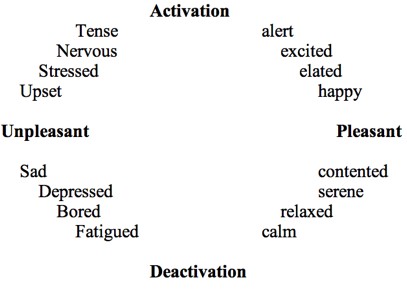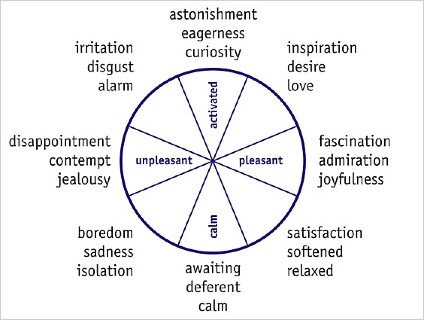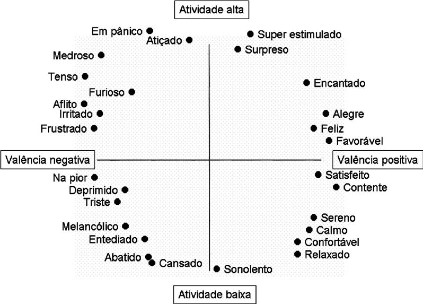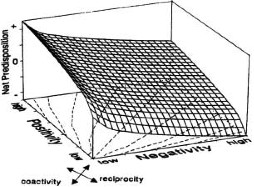Measuring Mood and Emotion

Gary Wolf
August 11, 2021
First published August 2009, Revised August 2021
This long post is an attempt to provoke QS readers to approach the question of measuring mood in some new ways. As self-researchers, you won’t be surprised to discover that measuring mood has been the subject of controversy. Those of you who are also academics won’t be surprised to know that the controversy has at times become hostile. But in it are clues to some of the problems immediately confronting anybody who is trying to track how they feel.
Let’s start the story in the 1980’s, when psychologists began to increasingly use a two dimensional model to describe and measure mood. The key paper is James A. Russell’s “A Circumplex Model of Affect,” published in 1980 in the Journal of Personality and Social Psychology. [Abstract] The circumplex model describes emotional space as a two dimensional grid. On the x-axis is “pleasantness/unpleasantness,” sometimes called “valence.” On the y-axis is “arousal,” or “activation.” Arranged in a rough circle around this two dimensional space are the varieties of human feeling, like this
There are lots variations on this circumplex.
 Source: (Framework of product experience, Pieter Desmet* and Paul Hekkert, IJDesign, Vol 1, No 1 (2007)
Source: (Framework of product experience, Pieter Desmet* and Paul Hekkert, IJDesign, Vol 1, No 1 (2007)

The nice thing about this model is that you can track mood with a mood checklist containing any number of terms, but whether you use more terms or fewer, this circumplex pattern is generally going to emerge. If you are only interested in the high level constructs, rather than in all the component descriptors, you should be able to approximate your mood with two questions: How happy do you feel? How energetic do you feel?
Or maybe not. In 1988, David Watson, Lee Anna Clark, and Auke Tellegen published a paper introducing the Positive and Negative Affect Schedule (PANAS), based on the idea that positive and negative affect should be separately tracked because they vary independently. In other words, it is possible to feel good and bad at the same time. To force mood tracking onto a bipolar two-dimension grid, when the supposed poles are not really opposites, is to risk distorting important observations.
Here is an example of a PANAS checklist, from a survey designed to measure emotions. You are asked to report to what extent you have felt this way during the time period being measured (right now, past few hours, past week, etc.).
———————————————————————————————————–
1 2 3 4 5
very slightly a little moderately quite a bit extremely
or not at all
______ cheerful ______ sad ______ active ______ angry at self
______ disgusted ______ calm ______ guilty ______ enthusiastic
______ attentive ______ afraid ______ joyful ______ downhearted
______ bashful ______ tired ______ nervous ______ sheepish
______ sluggish ______ amazed ______ lonely ______ distressed
______ daring ______ shaky ______ sleepy ______ blameworthy
______ surprised ______ happy ______ excited ______ determined
______ strong ______ timid ______ hostile ______ frightened
______ scornful ______ alone ______ proud ______ astonished
______ relaxed ______ alert ______ jittery ______ interested
______ irritable ______ upset ______ lively ______ loathing
______ delighted ______ angry ______ ashamed ____ confident
______ inspired ______ bold ______ at ease ______ energetic
______ fearless ______ blue ______ scared ______ concentrating
______ disgusted ______ shy ______ drowsy ______ dissatisfied with self
with self
_________________________________________________________________
The conflict between the circumplex model and the PANAS scales launched the bipolarity controversy. For a short taste of the polemics you can read Russell and James M Carroll’s The Phoenix of Bipolarity: Reply to Watson and Tellegen (1999). In this short essay, which served as a final salvo on the first stage of the controversy, the circumplex seemed to gain victory. It turned out that, in a wide range of measurement contexts, data from the PANAS showed evidence of bipolarity. Items from the poles of the circumplex descriptors had strong correlations, and the descriptors arranged themselves roughly around the circle. The opposition between happiness and sadness was not an artifact of the mode. Watson and Tellegen appeared to concede the most controversial points, and bipolarity was saved.
But this victory was not unambiguously satisfactory. Anybody with an ounce of reflective capacity can think of many examples of mixed emotion. Your good day comes to an end. You speak a foreign language enthusiastically, aware that lack of practice insures continued incompetence. You give successful aid to a beloved family member you’re seriously worried about. The intellectual critique given by Russell and Carroll to Watson and Tellegen may be definitive; and yet both positive and negative feelings about their triumph coexist. Must we really deny our own ambivalence? Since the topic at hand is subjective experience, why can’t we subjects get the last word?
In fact, this problem with the circumplex model has also been noticed by professionals, and looked into, and confirmed. Among the researchers to insist upon the independence of positive and negative feelings is John T. Cacioppo, who instead recommends the Evaluative Space model; you can read more about it in his paper: Relationship Between Attitudes and Evaluative Space; A Critical Review, With Emphasis on the Separability of Positive and Negative Substrates. [PDF]. Cacioppo proposed an architecture of the emotional space that looks like this. Please start redesigning your mood trackers now.

In a 2001 paper called Can People Feel Happy and Sad at the Same Time? [Abstract], Jeff T. Larsen, A. Peter McGraw, and Cacioppo used some experiments to reassert the claim that happiness and sadness can sometimes co-occur. Yes, happiness and sadness may usually correlate negatively; but, if they sometimes correlate positively, then they cannot be polar opposites. Another researcher, Eshkol Rafaeli (whose web site contains many interesting references), has put the label affective synchrony on the phenomenon of simultaneous happiness and sadness, and has done some work suggesting that all people are not alike when it comes to affective synchrony. Some people experience happiness and sadness as bipolar opposites; others have more experiences of mixed emotions. (See Rafaeli’s Affective Synchrony: Individual Differences in Mixed Emotions. [PDF])
At this point, I hope you are both happy and sad. Happy, that so much research on this question has been done for you. Sad, because this research remains contradictory where it is not confusing.
What would a good mood tracking protocol look like? Is there a clear, promising direction? If you only look at one of the references attached to this post, I recommend Lisa Feldman Barrett’s Solving the Emotion Paradox: Categorization and the Experience of Emotion [PDF]. Barrett offers both a wide-ranging review of the state of the art in modeling human emotion; more importantly, her theory of emotion offers some clear and plausible guidance for self-research.
Barrett divides emotion into two parts. Core affect is the totality of a person’s state that is available for emotional processing. The physiology of core affect is shared among animals. All of us carry out some degree of assessment along the lines of good and bad; and all of us vary in our level of energy. The fact that human descriptions of emotion clump together along the two dimensions of the circumplex reflects the structure of our core affect. This suggests that the circumplex is perfectly valid for many potential self-tracking experiments.
Let’s say we want to quit smoking, but we know that the process of quitting will make us tense and unhappy. Perhaps it would be prudent to have a way to observe our emotions that can show us patterns in the pain of quitting and even project a finish line beyond which these effects are likely to be negligible. Here the circumplex model ought to work. We are concerned about some basic elements of our emotional life — feelings of distress — in which our categories do not have to do very much subtle work. “These feelings” writes Feldman, “are primitive (psychologically irreducible) and universal…” But there are other situations in which the circumplex will fail us. Wherever the aim of our experiment is to understand and/or alter the more complex structure of our mood, we shouldn’t start with a measurement system that dramatically simplifies this structure.
Why should we be interested in the structure our moods? Here, the second part of Barrett’s paper is interesting. In her model of emotion, core affect is the material on which emotion works, but the experience of emotion – the inner experience, as well as most of the repertoire of outwardly emotional behavior – comes from the act of categorizing core affect, giving it a label such as “anger,” “sadness” or “fear.” This does not mean that the emotion is not experienced until you are conscious of putting a name on it. You don’t have to quietly mutter “anger” in order to feel anger. But it does suggest that anger is a concept that you begin learning in fancy and may continue to extend and revise throughout life. The repeated experience of labeling a combination of core affect and the context in which it occurs as “anger” trains you in how to be angry and how to recognize anger. Barrett describes emotions as simulations, in the sense that they take an experience of core affect, plus the situation in which it occurs, and compute an appropriate result:
“….conceptual knowledge about emotion constitutes expertise about how to deal with your own internal state – experienced as “an emotion” – and the situation or event that you believe caused that emotion in the first place. In this sense, emotional categorization is functional. Situated conceptualizations may be thought of as an inference about what will make for successful self-regulation or goal achievement…”
This is a theory of emotion that could be articulated by a robot, and it strikes me as entirely plausible. Here are the practical implications:
“…conceptualizing core affect as emotion, like conceptualizing in general, is a skill… This skill for wielding conceptual knowledge about emotion might be considered a core aspect of emotional intelligence… It is a skill to simulate the most appropriate or effective representation, or even to know when to inhibit a simulated conceptualization that has been incidentally primed. Presumably, this skill not only can be measured, it can also be trained.”
This suggests that we can revise our emotional architecture through experiments in description.
When I was just out of my teens I worked in a fancy restaurant under the close supervision of its chef-owner. He wanted us to sell wine to the customers, so he let us taste everything and trained us to describe it. The obscurity of the distinctions permissible in describing wine are notorious, but my sophomoric witticisms about buttery charcoal and leather buzzing with flies did not make him laugh. After a minute he said: “You are being asked to remember these wines. These adjectives are your labels. You’re welcome to make up your own, but then I can’t teach you and nobody will understand you.” Then he pulled the toque from his head and trampled it underfoot. No, that last part didn’t happen, but I did experience something like enlightenment, and the jargon became meaningful, allowing me to meet the demands of the situation. In the scheme Barrett describes, emotions are a kind of inner jargon, triggering a cascade of associations and providing labels that make it possible to form an intentional response.
Barrett’s theory of emotion opens the door for another type of self-tracking than is permitted by the circumplex, tracking that asks questions like: How many emotions do I have? What is the range of my emotions? Do I meet various experiences with well tuned emotional responses, or have my feelings become rigid and stereotyped? Her paper suggests that we can improve our emotional structure, increasing the granularity of emotional experiences by enriching our vocabulary and learning to apply it to previously unnoticed patterns in affect and context.
Today mood tracking takes two forms. One uses a scale to rate mood according to it’s valence. The other uses text to label mood with adjectives. This is the bipolarity debate, operationalized. Which tracking method you want to use will depend on your goals.
I’ll end with an idea about how this second type of mood tracking could work. First, let’s revisit two projects already underway: Ka-Ping Yee’s time allocation diary; and Atish Mehta’s Happy Factor. At the first QS Show&Tell, Ping showed us his time-allocation diary, which he keeps using a widget that stays open on his screen. He can enter some text into the box, where it automatically gets a time/date stamp. He often adds a keyword, so that he can graph his activities by category. Such a system is simple and flexible, and is not dependent on fixed categories; Ping can always start and maintain a new category simply by using a new word in his short entries.
Meanwhile, Atish has created a Facebook app that randomly queries users with a text message and asks them to rate their happiness. The ratings get a time/date stamp, and allow for the entry of a short note.
A mood tracking system to investigate emotional architecture might fruitfully combine these two methods. The ability to perform randomly timed queries is powerful. (For more on this, see “The Descriptive Experience Sampling Method” (PDF) by Russell T. Hurlburt and Sarah A. Akhter. I also discuss this method in a review of Describing Inner Experience by Hurlburt and philosopher Eric Schwitzgebel.) Right now Happy Factor asks only about happiness. Asking a constrained question such as “how happy are you” is only useful in the context of other data; to make use of Happy Factor as currently designed requires exporting the data and combining it with data about some other dimension of your life, in order to give it meaning. But think about if the question were unconstrained: “what emotion are you experiencing right now?” Suddenly, the descriptive landscape our mood becomes accessible. [Starting at about minute 12:00 in the video above, some of these ideas are batted around in the discussion, along with other interesting prospects.]
Once the structure of our moods became accessible for visualization, experiments and interventions become possible. The type of experiments or interventions that might be interesting is left as an exercise for the reader.
NOTES
I have used mood, feeling, and emotion interchangeably. Though they are not the same, similar questions of measurement apply. A good recent summary of the controversy over the circumplex is given in: Causes and Consequences of Feelings (Studies in Emotion and Social Interaction) (Paperback) by Leonard Berkowitz. The book is expensive but I’m happy to share the key pages if anybody needs them.


